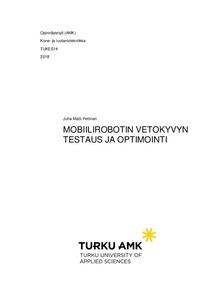| dc.contributor.author | Pettinen, Juha-Matti | |
| dc.date.accessioned | 2018-12-27T05:56:39Z | |
| dc.date.available | 2018-12-27T05:56:39Z | |
| dc.date.issued | 2018 | |
| dc.identifier.uri | URN:NBN:fi:amk-2018122422849 | |
| dc.identifier.uri | http://www.theseus.fi/handle/10024/159215 | |
| dc.description.abstract | Tämä opinnäytetyö käsittelee VMP Interiorin NEROBOT-mobiilirobottia ja sen prototyyppiasteella olevaa tarttujaa. NEROBOT on pienehkö itsenäisesti työskentelevä kuljetinrobotti, jonka tarkoituksena on vapauttaa henkilöstövoimaa yksinkertaisista kuljetustehtävistä tärkeämpiin tehtäviin.
Työn painopiste on mobiilirobotin vetokyvyn mittaamisessa, mutta samalla käsitellään myös kyseisen mobiilirobotin ja tarttujan runkojen soveltuvuutta tavoiteltavan maksimikuormituksen kuljettamiseen. Työssä käydään myös läpi yleisesti vihurivaunujen ja mittauksessa käytetyn voima-anturin tekniikkaa ja miten autonominen mobiilirobotti eroaa perinteisestä vihurivaunusta.
Vetokykyä testataan tasaisella alustalla kuormitusta asteittain lisäämällä niin pitkälle, että vetävien pyörien pito loppuu. Mittaus tehdään simuloimalla mobiilirobotille suunnitteilla olevaa laitehyllyä haarukkavaunulla. Mobiilirobotin tulee kyetä liikkumaan myös muualla kuin pelkästään täysin tasaisella alustalla, joten myöskin teoreettinen vetokyky nykysuositusten mukaisella luiskalla lasketaan.
Lopuksi käsitellään yksinkertaisia parannusideoita vetokyvyn kasvattamiseksi, kuten parantamalla mobiilirobotin rengastusta ja lisäämällä mobiilirobotin omapainoa. Samalla pohditaan myös näiden ideoiden soveltuvuutta käytäntöön. | fi |
| dc.description.abstract | This thesis discusses VMP Interior`s NEROBOT-mobile robot and a prototype gripping device for it. NEROBOT is a small autonomously working carrier robot which aims to release human resources from simple transport tasks to more demanding and important work.
The objective of this thesis was to measure the towing capacity of this mobile robot. The structures of the mobile robot and gripping device where also briefly studied to be sure that they are suitable for targeted workloads. This thesis also discusses briefly about automated guided vehicles in general and force sensor technology that was used in the tests. The differences of automated guided vehicles and autonomous mobile robots was discussed as well.
The towing capacity was tested on a flat surface and the load was added gradually to the robot so long that the tires of the robot were slipping. Because a towing cart for the robot was not available at the time of testing it was simulated with a hand pallet truck. The mobile robot must also be able to move beyond a perfect flat surface, so the theoretical towing capacity on a slope was calculated.
Lastly the topic of some simple improvement ideas for how to increase the towing capacity of the mobile robot was discussed, including better tires and increasing mobile robot`s weight and how to implement those ideas in real life and in what kinds of situations they are best suited for. | en |
| dc.language.iso | fin | |
| dc.publisher | Turun ammattikorkeakoulu | |
| dc.rights | All rights reserved | |
| dc.title | Mobiilirobotin vetokyvyn testaus ja optimointi | fi |
| dc.type.ontasot | fi=AMK-opinnäytetyö|sv=YH-examensarbete|en=Bachelor's thesis| | |
| dc.identifier.dscollection | 10024/101 | |
| dc.organization | Turun ammattikorkeakoulu | |
| dc.contributor.organization | Turun ammattikorkeakoulu | |
| dc.subject.keyword | mobiilirobotti | |
| dc.subject.keyword | vetokyky | |
| dc.subject.specialization | Tuotekehitystekniikka | |
| dc.subject.degreeprogram | fi=Konetekniikka|sv=Maskinteknik|en=Mechanical Engineering| | |
| dc.subject.discipline | Kone- ja tuotantotekniikka | |
